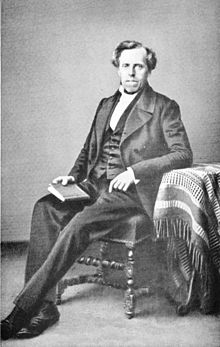
Chartres is a commune and capital of the Eure-et-Loir department in France. It is located about 90 km (56 mi) southwest of Paris. Chartres is famous world-wide for its cathedral. Mostly constructed between 1193 and 1250, this Gothic cathedral is in an exceptional state of preservation. The majority of the original stained glass windows survive intact, while the architecture has seen only minor changes since the early 13th century. Much of the old town, including the library associated with the School of Chartres, was destroyed by bombs in 1944.

Achille Valenciennes was a French zoologist.

Châteaudun is a commune in the Eure-et-Loir department in northern France. It is a sub-prefecture of the department.

Jules Pierre Rambur was a French entomologist.

Charles Oberthür was a French entomologist specializing in Lepidoptera. He was the son of François-Charles Oberthür.

Étienne Louis Geoffroy was a French entomologist and pharmacist. He was born in Paris and died in Soissons. He followed the binomial nomenclature of Carl von Linné and devoted himself mainly to beetles.

André Jean Baptiste Robineau-Desvoidy was a French physician and entomologist specialising in the study of Diptera (flies) and to some extent of the Coleoptera (beetles).

Charles Jean-Baptiste Amyot was a French lawyer and entomologist especially interested in the Hemiptera.

Charles Nicholas Aubé, was a French physician and entomologist.

Victor Antoine Signoret was a French pharmacologist, physician and entomologist.

Achille Richard was a French botanist, botanical illustrator and physician. The standard author abbreviation A.Rich. is used to indicate this person as the author when citing a botanical name.

Sylvain Auguste de Marseul was a French Roman Catholic priest and entomologist. He taught in the Petit séminaire de Paris from 1833 to 1836. In 1842, founded a college at Laval, then from 1850 to 1853, he taught in Paris. In 1854, he left his college for America where he remained eight months and discovered entomology. The abbot of Marseul was the author of many publications. He founded in 1864 a review devoted to the Coleoptera and named L'Abeille, the Bee. On his death this publication was continued by Ernest Marie Louis Bedel (1849-1922) then by René Gabriel Jeannel (1879-1965). The abbot also studied the history of the beginnings of French entomology in a series of review article in the Bee under the generic title Entomologistes et de leurs écrits, Entomologists and their writings. His collection is conserved in the Muséum national d'histoire naturelle and his library in the Société entomologique de France.
Achille Rémy Percheron was a French entomologist. He listed, in Bibliographie entomologique more than 5 000 authors and 500 anonymous contributions.

Louis Jérôme Reiche, was a French merchant, manufacturer and entomologist.

Jean-Baptiste Eugène Bellier de la Chavignerie was a French entomologist who specialised in Lepidoptera. After his studies in Chartres then Paris, Chavignerie worked at the Palais de Justice in Paris from 1844 to 1859. He was devoted to Lepidoptera and wrote many scientific papers on them, principally faunistic works. The most important were the faunas of the Auvergne (1850), the Alps, the Pyrénées-Orientales (1858), Sicily (1860) and Corsica (1861). Charles Oberthür (1845-1924) acquired his collection after his death.
Gaspard Auguste Brullé was a French entomologist.
Édouard Lefèvre was a French botanist and later entomologist who specialised in Coleoptera. He became a member of the Entomological Society of France in 1869, and twice served as president of the society in 1884 and 1893.

Claudius Rey was a French entomologist.
Hyalorista opalizalis is a pyraloid moth in the subfamily Pyraustinae of the family Crambidae. It was described in 1854 by the French entomologist Achille Guenée based on two male and two female adult specimens collected in Brazil.

Pierre Chrétien was a French entomologist who specialised in Lepidoptera. He was a member of Société entomologique de France. Trifurcula chretieniZ. & A. Lastuvka & van Nieukerken, 2013 is "named in honour of Pierre Chrétien (1846–1934), who discovered nepticulid mines on Bupleurum, including those on Bupleurum rigidum, and the first author to describe a number of Mediterranean species that are now placed in Trifurcula (Glaucolepis)." His collection is held by National Museum of Natural History in Paris.
















